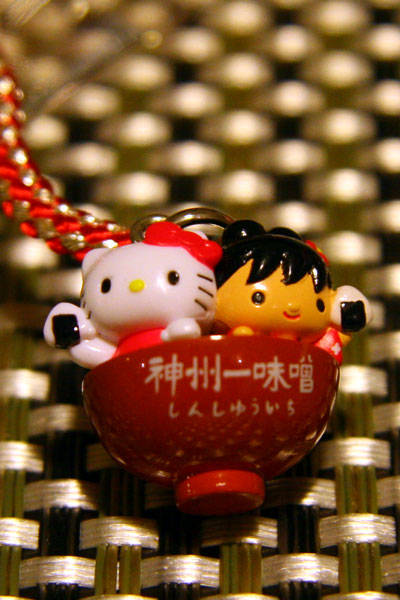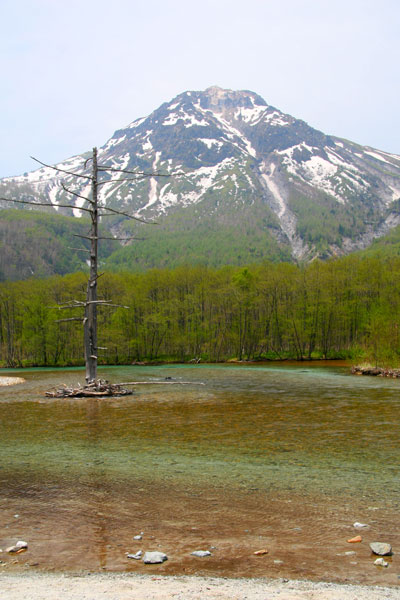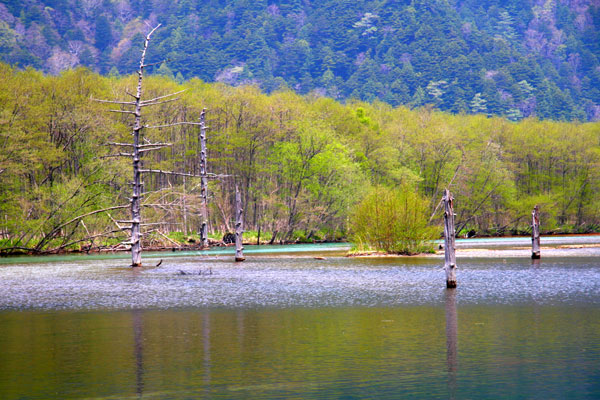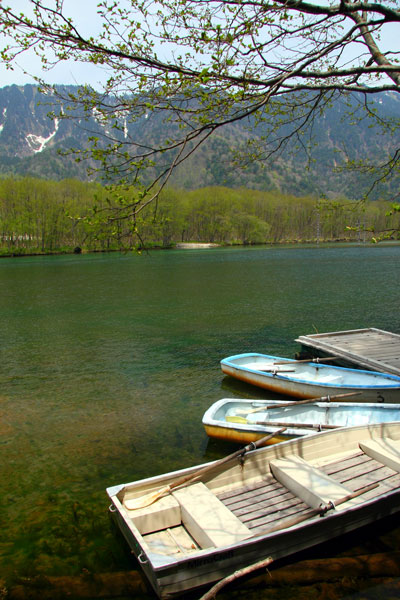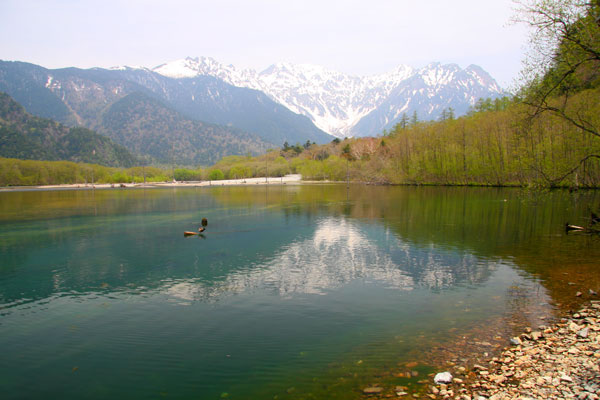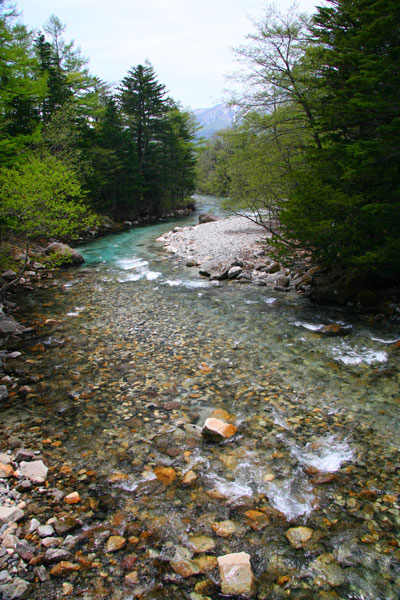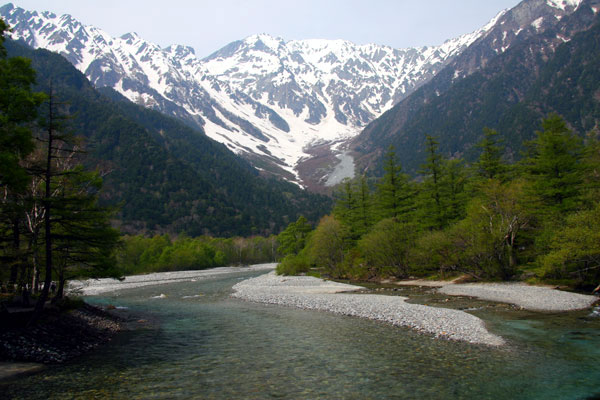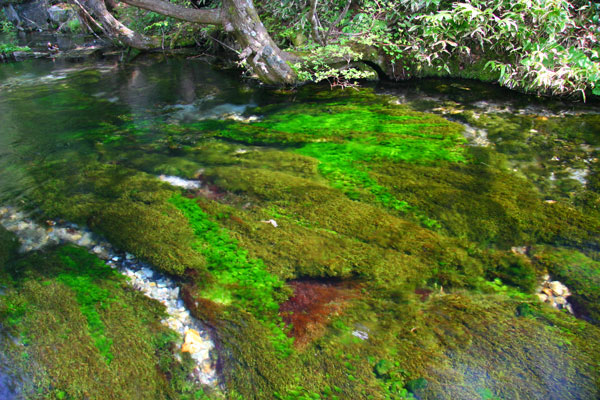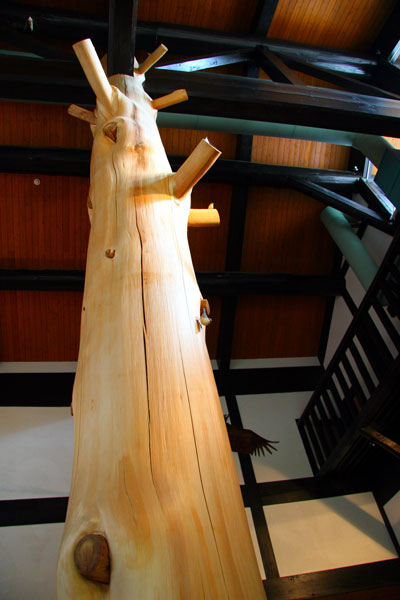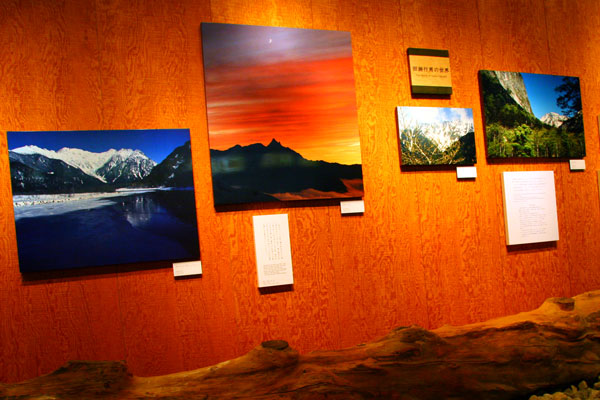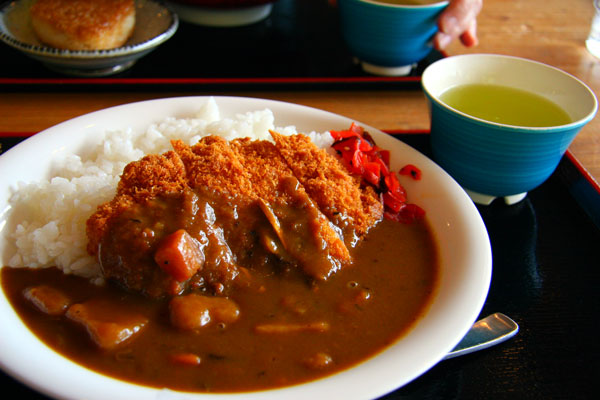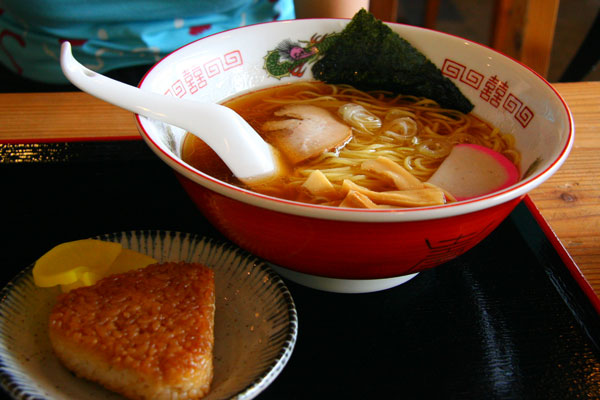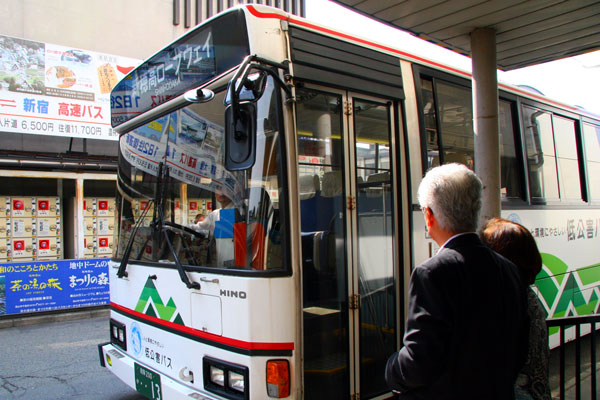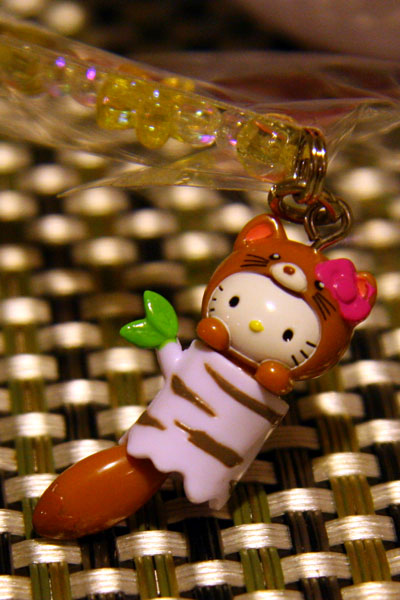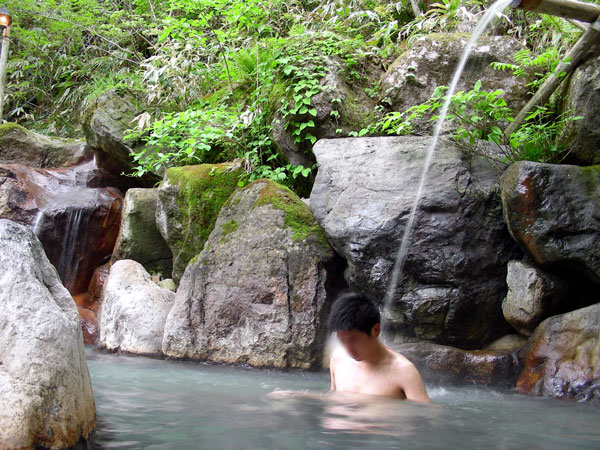
My skin must have wrinkled like a relief map of the surrounding mountains of Central Japan, as I took 4 baths in 9 different hotspring pools -- all in the course of a 16-hour period.
Even though I've had some hotspring experience in Canada, Hungary and Eastern Japan prior to this trip, to visit a mountain-side hotspring in its natural state in the hotspring-crazed nation of Japan was a highlight I looked forward to for months leading to the day. This was in a remote mountain valley in Central Japan, situated at a turn-off on Route 158 halfway between the cities of Takayama and Matsumoto, not far from the road into Kamikochi. This valley consists of a loose collection of five little hotspring towns -- Hirayu, Shin-Hirayu, Fukuchi, Tochio, and Shin-Hotaka -- known together as Oku-Hida Onsengo.

We picked Hirayu Onsen out of the five towns for our overnight stay, mainly due to its location as the main transportation hub in the region. This allowed us to arrive from Takayama in the morning, take a 30-minute bus ride to see the National Park at Kamikochi, return in the late afternoon for some bathing, then depart for Matsumoto the next morning.
Upon arrival at Hirayu Onsen, one of the most recognizable landmarks was the tall lantern-stand outside the entrance of our Ryokan (more about it below), and the narrow hotspring pool at its stone base providing a free-of-charge foot bath for weary travelers waiting for the next bus connection. There's another bigger foot bath at the centre of the village if you're a foot bath fan, but this one is located next to the bus terminal and allows you to see the buses coming in while you enjoy the water.
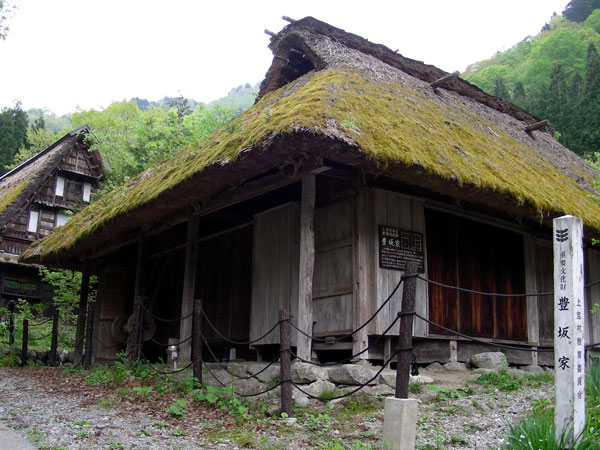
Hirayu Onsen is an Onsen (hotspring) town after all, and sightseeing attractions is just not its forte. There is one little museum in town known as the Hirayu Minzoku-kan which exhibits three thatched-roof farmhouses, but the main draw for the 500-yen entrance fee is the bathing in the open-air hotspring pool within the museum grounds.
The other attraction in town is the large park surrounding the Hirayu Ootaki, famous for its illuminated display of a frozen waterfall during the winter. We felt that it didn't justify our time as we arrived in May ... we've seen enough waterfalls living in Canada.

The town itself was small and nondescript, and could be mistaken for any of the hundreds of similar hotspring towns across Japan. But as all hotspring-goers know, it's the quality and ambience of the hotspring pools that really matters. So I thought I'd start by seeking out the town's most famous hotspring pool ...

... the Kami-no-Yu, the small, rustic great-granddaddy of all hotsprings in the region. Legend has it that an invading 16th Century warlord discovered this copious source of spring water, which has stayed true to its origin as just a couple of natural rock-lined pools in the middle of the wilderness. This is pretty remarkable considering the Japanese tendency to over-develop any hotspring resort -- just look at the "original" hotspring pool in Gero just a couple hours drive to the southwest ... the source once-revered as one of the "Three Famous Hotsprings" is now just a concrete pool right underneath a highway overpass surrounded by a myriad of ugly hotels. Talk about killing the goose that laid the golden egg!
As you can see I was pretty stoked about my first dip in a Japanese natural hotspring ... one that is outside a Ryokan or a public bathhouse. The path to Kami-no-Yu was well marked with signs like this one ... no English on the signage of course, nor do they expect any foreigners. Even though the town brochure said 10 minutes walking distance, it probably took me closer to 20 minutes as it turned out to be a long, winding uphill climb, which seemed even longer as the occasionally bather zoomed by in a car.
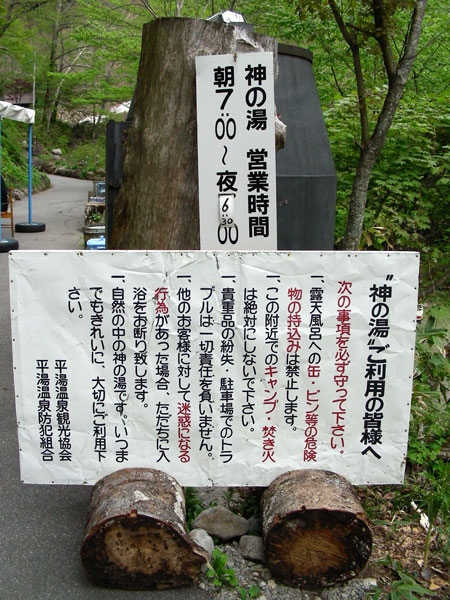
Already out of breath and in desperate need for a hot bath to recuperate my thighs, I finally made it to the entrance at about 17:00. As you can see the closing time seemed to vary with little warning, and I suspect they would just close sooner on slower days and run until 19:00 on holidays and weekends. The other finer prints are just the generic bathing rules such as "No bottles and cans in the open-air bath." A few metres after this sign stood the concession stand, where a middle aged lady collected my 500 yen (CAD$5) entrance fee and also sold various refreshments and fruits. Well, it's not TOO basic after all -- I would have loved a free bath.

As it turned out there were a total of four pools -- one open-air bath for males, one for females, one private indoor bath for families, and one other private bath in the form of a giant metal pot. So ... no Konyoku (mixed-sex bathing) ... unless you bring your whole family and have a big bath together like some Japanese families do. Once you choose the pool you want, it's just a matter of stashing your clothes inside one of the baskets in the little wooden shed (no lockers ... so don't bring anything valuable), then bring your own Tenugui (small wiping cloth) with you and head off to the bath.
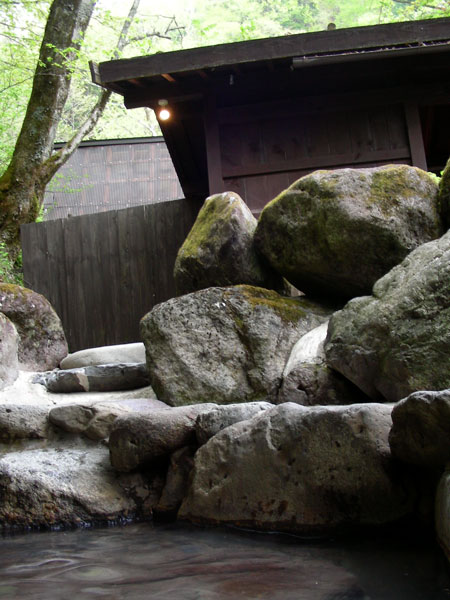
And bring your own soap and shampoo too if you don't want to use the generic body soap offered by the facility, as Japanese bathing etiquette requires cleaning and rinsing oneself thoroughly before venturing into the pool. As I stood naked and washed myself at the pool side, the faint odor of sulphur emanated in the air, almost in an inviting way as I prepared to test the water temperature with my feet.
The edge of the pool was warmer than luke-warm, but not as hot as I would prefer. It started at only around 37 degrees Celcius by my estimation, but got increasingly higher close to the spring source, which was directed into the pool from above using a bamboo pole. The colour of the water was just slightly yellow, and bits of whitish minerals could be seen suspended in the cloudy water. Just two middle-aged Japanese men shared the bath with me on this weekday afternoon in May. Neither stayed for very long, which was great since I could then bring out my cheap point-and-shoot camera for a few pics of my own.

Now THIS was the hotspring experience I had come for -- a shoulder massage from the steaming hot water source, hidden in the seclusion of nature and uninterrupted by any other bather. This moment alone was worth spending the night at this little hotspring town in the middle of nowhere. And the spring source was HOT!!! Very hot in fact, even higher than the maximum 42 degrees Celcius offered at most hotspring resorts. I couldn't last very long under this temperature and had to get out of the pool, cool myself down, then get my other shoulder massaged and so on for a few times.
After 40 minutes or so all my aches were gone, and of course the road back to town was all downhill from here, so to speak. Funny I never noticed the beauty of the lush green forest and the serene mountain stream during the grinding uphill walk ...
Hotel Review: HIRAYU-NO-MORI (Hirayu Onsen)
Address: Gifu-ken Takayama-shi Oku-Hida Onsengo Hirayu 763-1
Price: 9000 yen per person including dinner and breakfast (1000 yen less for rooms without private bathrooms)
Website/Map: http://www.hirayunomori.co.jp
How To Book: Through the official website
Directions: One minute walk from the Hirayu Onsen bus terminal, towards the uphill side on the right side of the road.

Baths, baths and even more open-air baths ... this is the main reason people come to Oku-Hida Onsengo. I have to borrow a picture from the Ryokan's official site since I took the bath at night and didn't bring my camera. Please contact me if you're the owner of this photograph and would like me to take this photo down. Otherwise, this is an excellent illustration of the hotspring experience you can expect at any one of the many Ryokans along this valley.
Being one of the largest Ryokans in the region, Hirayu-no-Mori boasts a total of 16 fully open-air hotspring pools, with 7 on the male side and 9 on the female side. I walked in at the uncharacteristic hour of 21:00, when almost all of the guests have retired to their rooms and I had sole possession of all 7 hotspring pools on the male side. It was a clear early summer night, with the sky so clear that I could pick out the big dipper and the milky way while floating in the hotspring pools. And yes, I did try all 7 of the pools, and ended up spending most of my time in the two hottest ones.

Again there was no mixed-sex bathing in the public section, but for couples and families, the Ryokan provided a few private baths for its guests on a first-come-first-serve basis. These were giant semi-outdoor bathtubs in the form of semi-spherical metal pots, divided into an indoor half and an outdoor half by a wooden sliding divider. With a roof over the head and just metres from the Ryokan property's wooden fence, there really wasn't much of a view to speak of. But somehow we found it so relaxing that we came back for one more dip the next morning before checking out.

You don't even need to stay overnight in Hirayu-no-Mori to enjoy the bathing facilities, as the Ryokan offers a "Day Bathing" ticket for a measly 500 yen (CAD$5), which is the same price as the natural Kami-no-Yu but with a whole selection of nicer, albeit artificial pools. This could be a great plan if you're only passing through this area for the day, and are in need for a hotspring fix and a lunch spot. There is one public restaurant in the Ryokan, serving typical Central Japanese dishes such as Hida Beef and wild mountain vegetables.

You can see the sign of a successful hotspring Ryokan by the plethora of souvenir items in its gift shop. Most of these would make nice gifts to bring home to friends and family, but for us there is only one essential item to bring home ...

... Oku-Hida Onsengo's own Yu-no-Hana, the mineral salts collected from the evaporation of the hotspring water and the true essence of any Onsen. Two spoonfuls into my bathtub and I can enjoy the same cloudy, skin-smoothening hotspring water at the comfort of my home. This is by far the best natural bath salt I've ever used, and it's only 315 yen (CAD$3) for each 250 gram pouch.
So the bathing facilities were quite excellent, now what about the room and the meals?

There are at least three types of rooms to choose from. Our Tatami-mat room with ensuite bathroom cost 9000 yen (CAD$90) per person including dinner and breakfast, and a Western (2 single beds) room with ensuite bathroom also went for the same price. If you can do without your own private bathroom, you can get a Tatami-mat room for only 8000 yen (CAD$80) per person. Now this is the weekday rate, as the price goes up a little on Saturdays, holidays and the summer peak season. If you're a fan of hotsprings, or if you just want an authentic Japanese hotspring resort experience, 8000 yen per person including dinner and breakfast is fairly hard to beat as far as full-service Ryokans go.
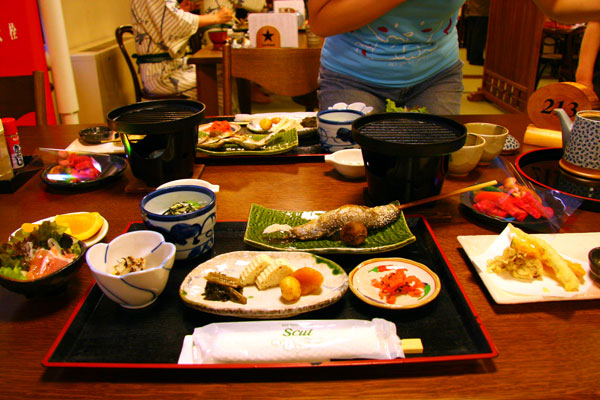
On to the dinner, which was quite ordinary and simple by Ryokan standards, but still consisted of nine courses.

Once again we're served the signature dish of any rustic Central Japanese dinner -- a roasted Iwana trout dusted with sea salt. The pairing of the saltiness of the Iwana Shioyaki with a sweet chestnut was interesting though. First of all that's quite a contrast of flavors and textures, and secondly ... I thought chestnuts are usually served in the Autumn season as far as Japanese cuisine goes!
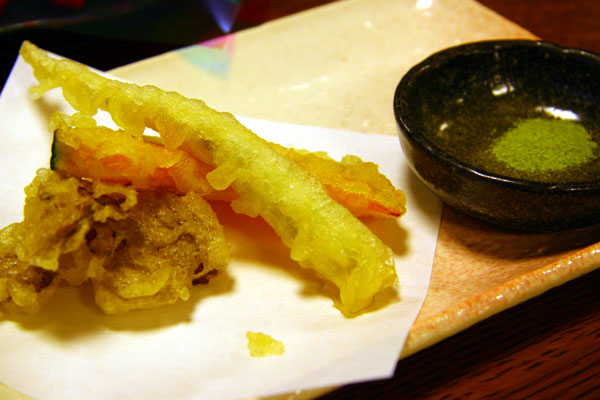
To me the interesting thing about this dish wasn't the tempura itself, but the Chef's display of confidence in his own ability evident through his decision of presenting Matcha salt instead of the ubiquitous Ten-tsuyu sauce for dipping. This showed that the Chef wanted his clients to focus on the delicate flavors of his choice ingredients, consisting of Maitake mushrooms, Kabocha squash, and a bamboo shoot. This was probably the best dish of the meal, though IMHO it's still a notch or two lower than what I would expect from a Tempura specialist restaurant ... the amount of residual oil was too heavy for this dish to be considered a complete success.
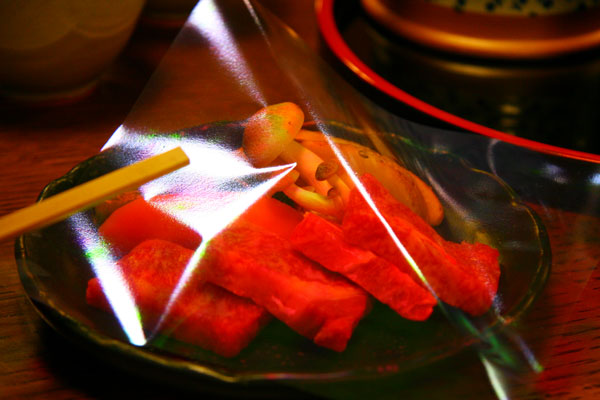
At the end we came to the dinner's most expensive ingredient -- four thick slices of the region's famous Hida Beef. Well, let's take off the decorative wrapping and examine the beef marbling ...

Well, there was a fair amount of marbling content, but the distribution wasn't entirely even -- you could see a large white area of fatty connective tissue in each of the four slices, and certain areas without any marbling. As expected this wasn't quite as tender as some of the other Hida Beef dishes we've had on this trip -- in fact this was probably the lowest in quality ... an A3 by my estimation. If you want to see a visual comparison against top A5 quality Hida Beef, take a look at the Hida Beef in Hoba Miso at Shirakawago's Shiraogi restaurant.

The next morning we started our routine with another hotspring dip in the private Kama-furo bath, then went to the restaurant for breakfast at 07:00. Once again the breakfast was simple by Ryokan standards, but of course the rice was all-you-can-eat, and we did find our meal quite enjoyable due to two of our favorite breakfast items ...
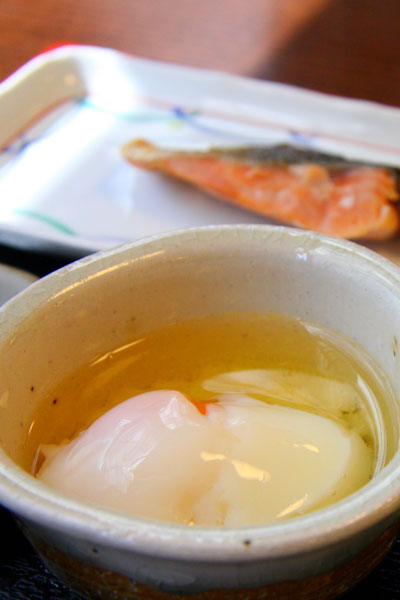
It was my wife's favorite again -- the Onsen Tamago (hotspring egg) served in Dashi broth. Even though we've been having this dish practically once every couple mornings, we just couldn't get enough of this incredible smoothness of the soft-boiled yolk surrounded by the even softer egg white. I should try to make this at home sometime ... once I get a decent water thermometer to help me keep the water at exactly 70 degrees Celcius for half an hour.

Then it was time for my favorite -- the quintessential Central Japanese dish of Hoba Miso, prepared simply by placing the local red miso and vegetables on top of a dried magnolia leaf and grilling on an open flame. The portion here wasn't quite generous enough for my liking, but it was still memorable as this turned out to the my last encounter with Hoba Miso on this trip. I still wish I had bought a stack of Hoba leaves back in Hida Takayama ... I'm missing this dish so much as I ponder what to cook for breakfast on lazy weekends.
Now we've seen it all ... the hotspring, the room and the meals ... but was it worth the 9000 yen (CAD$90) per person? Frankly the main selling point here is the wide selection of open-air hotspring baths, and it almost seemed that everything else was deemed secondary by the Ryokan management. The room was comfortable but really nothing to write home about, and the meals were quite ordinary really, in terms of both quality and quantity ... or perhaps we're just spoilt by the Ryori Ryokans (gourmet inns) we visited earlier during this trip. Nevertheless 9000 yen was still a fairly cheap price for a full-service Ryokan with excellent hotspring facilities, and taking into account its excellent location as a base for visiting Kamikochi on a day trip, I really should have no complaints.
TRANSPORTATION

Forget about train service to this treacherous region in the middle of the Japan Alps -- highway buses serve as the main form of public transportation here, operated mostly by the Nohi Bus company. The bus terminal at Hirayu Onsen (shown above) is the major transportation hub of the region and the gateway into the other four hotspring towns, as well as to the National Park resort of Kamikochi.
Multiple daily connections run to Takayama (1 hour to the west) and Matsumoto (1.5 hour to the east), both being popular tourist destinations and well worth your visit (see the two articles on Takayama here and here if interested). Both Takayama and Matsumoto are major stations on the JR Train network, and you should have no problem connecting to Tokyo or Osaka in one or two transfers. See Nohi Bus' English website for the latest bus timetables.
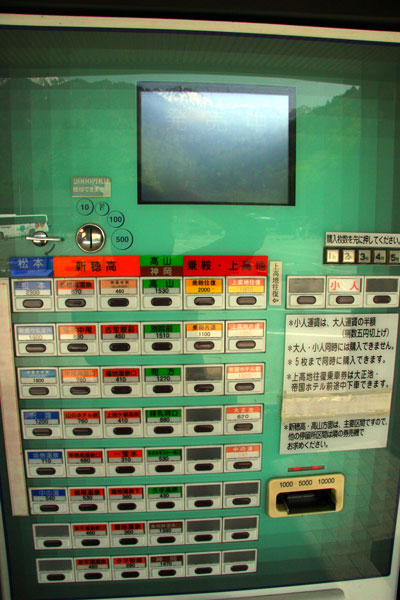
If you're planning to arrive from Tokyo directly without stopping over at Matsumoto or Takayama, Nohi Bus operates a daily service from Shinjuku that will take you to Hirayu Onsen in about 5 hours. But this bus is by reservations only, and you need to either phone up Nohi Bus' reservation centre (and be able to speak Japanese), or book through a bus ticket reservation website such as J-Bus (and be able to read Japanese). For most foreigners it's probably easiest to just hop on the Chuo Line train from Shinjuku to Matsumoto, then transfer to the Nohi Bus.
12:02 AM | 0
komentar | Read More

